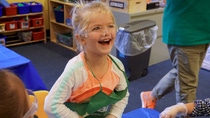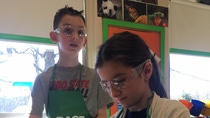Media
Kids’ Lab turns fourth graders into forensic scientists for a day
Grade schoolers solve a chemistry caper while learning about chromatography during a hands-on chemistry program.

They might not be the CSI: Crime Scene Investigation Team just yet, but these fourth graders were already solving a mystery—a lunch mystery— that is.
A class of 20 students at Thomas Jefferson Elementary in Morristown, N.J., were tasked with conducting a chromatography experiment—a process of separating and analyzing mixtures of chemicals contained in a compound substance into individual components.
The mystery entailed finding the perpetrator who stole a coworker’s lunch, but left behind a note written in a marker on a coffee filter. Four pictured suspects were presented, each using a different marker (Crayola, Sharpie, etc.) And it was the students’ job to use chromatography to find out which one of them did it based on the marker used. Since a black marker is made up of various colors that differs depending on its brand, the experiment was aimed at breaking apart the black color to show what other shades make up each of the four markers.
Using chromatography paper, paper clips, straws, beakers and four different markers, the fourth graders drew a line on a different strip of chromatography paper with each of the four markers. The permanent markers went into beakers with rubbing alcohol and the water-soluble ones were dipped into beakers with water. The liquid traveled up the paper and separated the black color into its components. The students then compared their results to the note to determine who stole the lunch.

“I like how the alcohol and water climbed up the paper,” said Nate Kuhlin, age 9, one of the partakers in the experiment.
The Chemistry Caper is just one of the activities that Kids’ Lab offers to grade schoolers as part of BASF’s science education program. Kids’ Lab is a hands-on activity for children aged 6-12 meant to inspire future generations’ interest in studying science technology, engineering and math (STEM). The students use BASF branded materials and experiments coupled with interactive Q&A and demonstrations to learn about chemistry.
What started as a program at BASF’s headquarters in Germany 20 years ago, was rolled-out in North America in 2010. The program started on the weekends at Liberty Science Center in Jersey City, N.J. and later expanded to eight other venues. In addition to these venues, employees bring these programs to local schools. Since its launch in North America, more than 150,000 children have participated in the program.
“I like science, I like learning about it, it’s interesting,” said Skye Romano, 9, another participant in the chemistry experiment.
“We believe the earlier kids are exposed to science, the more likely they are to fall in love with it,” said Bryan Knill, Science Education & Community Relations Coordinator, BASF, who assists in the program. “Children are naturally more prone to wonder and explore at a young age and if you show them science can be fun, they’re more likely to engage in STEM activities as they get older.”
Since science supplies tend to be pricey for a school, BASF provides the necessary materials to an institution in addition to science education.
“This is a hands-on program that allows kids to work on something different than the current curriculum,” said Gabrielle Meyer, the science specialist teacher at Thomas Jefferson Elementary, whose students have been taking part in Kids’ Lab for the past seven years. “BASF helps the kids hear someone else other than their teacher speak about science.”
Molly Borst, Manager, Science Education—North America, BASF, has been managing Kids’ Lab for the past seven years.
“Many K-8 schools do not have a formal science program in the classroom, and if they do, the students only receive a science class once a week or once a month,” she said. “Sometimes teachers are unable to make the class hands-on and rely on textbooks or videos. Kids’ Lab allows students to become scientists. We make it a fun and positive experience.”
Published by Anna Spiewak.
For media inquiries or to repurpose this article, contact Lisa Brown.